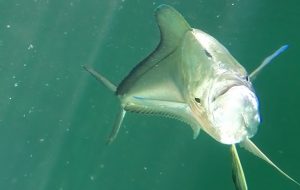Study Suggests Wider Range of Mahi-Mahi’s Genetic Responses to Oil Exposure
– OCTOBER 4, 2016
Scientists used novel bioinformatics to investigate molecular-level changes over time and toxicity pathways in mahi-mahi embryos and larvae exposed to Deepwater Horizon oil. They observed that weathered oil (collected from slick skimming operations) induced more pronounced gene expression changes than a non-weathered source oil (collected from the subsea containment system directly over the wellhead). The tools predicted impairment of heart rates and increased pericardial edema which the researchers observed in the fish. The method also predicted disturbances in eye and nervous system development. These results suggest new genetic and developmental toxicity pathways targets associated with Deepwater Horizon oil. They published their findings in Environmental Science and Technology: Time- and oil-dependent transcriptomic and physiological responses to Deepwater Horizon oil in mahi-mahi (Coryphaena hippurus) embryos and larvae.
The timing and location of the oil spill coincided with the spawning window for many economically and ecologically important Gulf of Mexico fish species. Natural weathering processes can significantly alter the composition and structure of individual polyaromatic hydrocarbons in the water column possibly increasing oil toxicity. This study builds on recent research about early life stage fish heart health and oil exposure. Researchers conducted exposure experiments with mahi-mahi embryos and water-accommodated fractions of weathered and non-weathered oil at 24, 48, and 96 hours post-fertilization. Using high throughput RNA sequencing and gene signature identification software (On-RAMP; Ingenuity Pathway Analysis), the team analyzed the regulatory directions of gene expression, making it possible to predict additional biochemical, cellular, and tissue pathways targets for the oil.
The researchers observed that both oils induced similar molecular responses at 24 hours, but there were more prominent changes in gene expression in weathered oiled treatments at 48 and 96 hours. The number of genes that were differentially expressed increased from 196 (48 hours) to 1,469 (96 hours) in weathered-oil treatments compared to increases of 128 to 297, respectively, in non-weathered oil treatments. The study provides more detailed genomic responses which indicate affecting specific molecular functions may be altered.
“By understanding how fossil fuels cause toxicity, we can have a better understanding of the risks associated with these contaminants and determine regulatory or management strategies that reduce risks,” commented study co-author Daniel Schlenk. “This experiment was the first to demonstrate that weathered oil more significantly altered gene expression than unweathered oil and suggests that there are multiple targets of oil toxicity to this species at this life stage, including the heart, eye, and neurological systems.”
The researchers noted that their use of rapid genomics annotation analyses coupled with advanced informatics tools may be useful elsewhere to identify species specific molecular and physiological responses to environmental contamination.
Time-lapse video provided by Dan DiNicola, RECOVER Outreach Coordinator
Data are publicly available through the Gulf of Mexico Research Initiative Information & Data Cooperative (GRIIDC) at https://data.gulfresearchinitiative.org (doi:10.7266/N7BG2M0J).
The study’s authors are Elvis Genbo Xu, Edward M. Mager, Martin Grosell, Christina Pasparakis, Lela S. Schlenker, John D. Stieglitz, Daniel Benetti, E. Starr Hazard, Sean M. Courtney, Graciel Diamante, Juliane Freitas, Gary Hardiman, and Daniel Schlenk.
************
This research was made possible in part by a grant from the Gulf of Mexico Research Initiative (GoMRI) to the Relationship of Effects of Cardiac Outcomes in Fish for Validation of Ecological Risk (RECOVER) consortium. Other funding sources included the Medical University of South Carolina College of Medicine and the Genomics Shared Resource, Hollings Cancer Center.
The Gulf of Mexico Research Initiative (GoMRI) is a 10-year independent research program established to study the effect, and the potential associated impact, of hydrocarbon releases on the environment and public health, as well as to develop improved spill mitigation, oil detection, characterization and remediation technologies. An independent and academic 20-member Research Board makes the funding and research direction decisions to ensure the intellectual quality, effectiveness and academic independence of the GoMRI research. All research data, findings and publications will be made publicly available. The program was established through a $500 million financial commitment from BP. For more information, visit https://gulfresearchinitiative.org/.
© Copyright 2010-2017 Gulf of Mexico Research Initiative (GoMRI) – All Rights Reserved. Redistribution is encouraged with acknowledgement to the Gulf of Mexico Research Initiative (GoMRI). Please credit images and/or videos as done in each article. Questions? Contact web-content editor Nilde “Maggie” Dannreuther, Northern Gulf Institute, Mississippi State University (maggied@ngi.msstate.edu).






